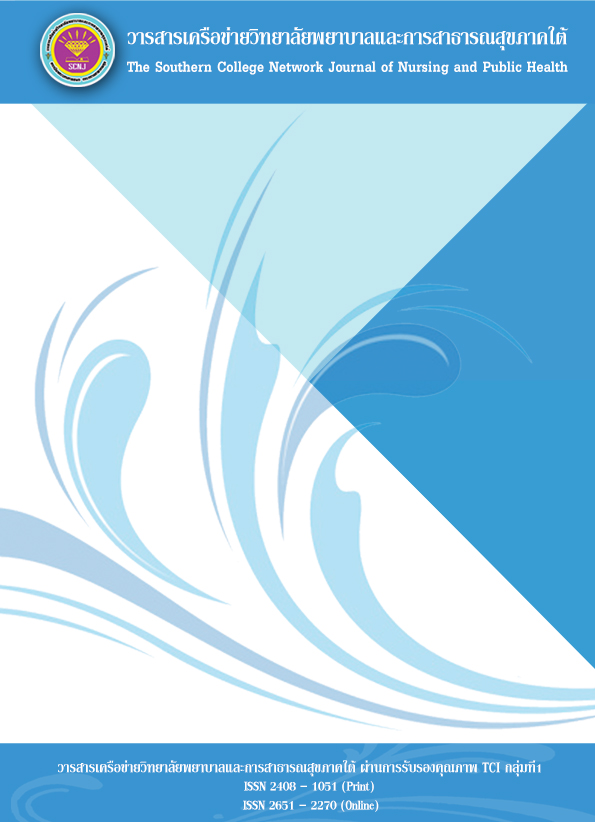ผลของโปรแกรมเสริมสร้างความแข็งแกร่งในชีวิตต่อความแข็งแกร่งในชีวิต ของนักศึกษาพยาบาลศาสตรบัณฑิตชั้นปีที่ 1 วิทยาลัยพยาบาลบรมราชชนนี นครราชสีมา
คำสำคัญ:
ความแข็งแกร่งในชีวิต, โปรแกรมเสริมสร้างความแข็งแกร่งในชีวิต, นักศึกษาพยาบาลศาสตร์บทคัดย่อ
การวิจัยกึ่งทดลองนี้มีวัตถุประสงค์ 1) เพื่อเปรียบเทียบคะแนนเฉลี่ยความแข็งแกร่งในชีวิตในกลุ่มทดลองก่อนและหลังได้รับโปรแกรมเสริมสร้างความแข็งแกร่งในชีวิต และ 2) เพื่อเปรียบเทียบคะแนนเฉลี่ยความแข็งแกร่งในชีวิตระหว่างกลุ่มทดลอง และกลุ่มควบคุมหลังได้รับโปรแกรมเสริมสร้างความแข็งแกร่งในชีวิตของนักศึกษาพยาบาลศาสตร์บัณฑิตชั้นปีที่ 1 วิทยาลัยพยาบาลบรมราชชนนีนครราชสีมา กลุ่มตัวอย่าง โดยการสุ่มอย่างง่าย จำนวน 20 คนและจับฉลาก แบ่งนักศึกษาเป็น 2 กลุ่ม โดยการสุ่มแบบจำแนกกลุ่มควบคุมและกลุ่มทดลอง อย่างละ 10 คน กลุ่มทดลองได้รับโปรแกรมเสริมสร้างความแข็งแกร่งในชีวิต มีกิจกรรม จำนวน 6 ครั้ง ส่วนกลุ่มควบคุมเข้าร่วมกิจกรรมที่วิทยาลัยจัดให้ตามปกติ ดำเนินการวิจัยในช่วงเดือนสิงหาคม-เดือนตุลาคม พ.ศ. 2560 เครื่องมือที่ใช้ในการศึกษา คือ 1) โปรแกรมเสริมสร้างความแข็งแกร่งในชีวิตที่ผ่านการตรวจสอบความตรงของเนื้อหา มีค่าระหว่าง 0.67 - 1.00 2) แบบสอบถามข้อมูลส่วนบุคคล และ 3) แบบประเมินความแข็งแกร่งในชีวิต ผ่านการตรวจสอบวิเคราะห์ความเชื่อมั่นโดยใช้สูตรสัมประสิทธิ์แอลฟาของครอนบาค มีค่าความเชื่อมั่นเท่ากับ 0.92 วิเคราะห์ข้อมูลโดยใช้ค่าเฉลี่ย ส่วนเบี่ยงเบนมาตรฐาน สถิติใช้สถิตินอนพาราเมตริกทดสอบของ Wilcoxon Signed-Ranks test และสถิติ The Mann-Whitney U test ผลการวิจัยพบว่า
หลังการทดลองนักศึกษากลุ่มทดลองมีคะแนนเฉลี่ยความแข็งแกร่งในชีวิต สูงกว่าก่อนการทดลอง อย่างมีนัยสำคัญทางสถิติที่ระดับ .05 และ หลังการทดลองกลุ่มทดลองมีคะแนนเฉลี่ยความแข็งแกร่งในชีวิตของกลุ่มทดลองสูงกว่ากลุ่มควบคุมอย่างมีนัยสำคัญทางสถิติที่ระดับ .05
ควรมีเสริมกิจกรรมในการเรียนการสอนทั้งในและนอกหลักสูตรเพื่อพัฒนาความแข็งแกร่งในชีวิตของนักศึกษาพยาบาล ชั้นปีที่ 1 เพื่อให้นักศึกษาพยาบาลมีความแข็งแกร่งในชีวิตควบคู่ไปกับการพัฒนาด้านความรู้เชิงวิชาชีพพยาบาล
เอกสารอ้างอิง
Chitrak, W., Nintachan, P., & Taweekoon, T. (2015). The Effect of the Resilience Enhancing Program on Depression and Resilience of Nursing Students in a Nursing College in the Northeast Region of Thailand. The Journal of Psychiatric Nursing and Mental Health, 29(3), 42–60. (In Thai)
Grotberg, E. H. (1995). A Guide to Promoting Resilience in Children: Strengthening the Human Spirit. The Hague: Bernard Van Leer Foundation.
Grotberg, E. H. (1996). The International Resilience Project Findings from the Research and the Effectiveness of Interventions. Retrieved March 16, 2019, from https://eric.ed.gov/ ?id=ED419584
Grotberg, E. H. (1999). Countering Depression with the Five Building Blocks of Resilience. Reaching Today’s Youth, 4(1), 66–72.
Laddawan Petchrot, L., & Chamniprasat, A. (2004). Research Methodology. Bangkok: Phim Dee Printing Co., Ltd (In Thai)
Limsuwan, N., Piyavhakul, N., & Arunpongpaisal, S. (2007). Satir Model. Journal of the Psychiatric Association of Thailand, 52(1), 1-7. (In Thai)
Nakwaree, N., Nintachan, P., & Sangon, S. (2015). Effect of the Resilience-Enhancing Program in Junior High School Students. The Journal of Psychiatric Nursing and Mental Health, 29(2), 46–63. (In Thai)
Nintachan, P., Sangon, S., & Thaweekoo, S. (2012). The Effect of the Resilience Enhancing Program in Graduate Nursing Students. The Journal of Nursing, 61(2), 18-27. (In Thai)
Nintachan, P., Thaweekoo, S., Wittayasooporn, W., & Orathai, P. (2011). Resilience and Stress Among Nursing Students at Ramathibodi School of Nursing. The Journal of Psychiatric Nursing and Mental Health, 25(1), 1-13. (In Thai)
Patamporn, P., & Sawitree, W. (2017). Experience in Breathing Meditation Practing for Decrease the Tension in Testing Maternal-Newborn and Midwifely 2 Subject of Nursing Student. The Southern College Network Journal of Nursing and Public Health, 4(1), 171-179. (In Thai)
Satir, V. (1991). The Satir Model: Family Therapy and Beyond. Palo Alto: Science and Behavior Books.
Yalom, I. D. (1995). The Theory and Practice of Group Psychotherapy (4th ed.). New York: Basic Books.
ดาวน์โหลด
เผยแพร่แล้ว
ฉบับ
ประเภทบทความ
สัญญาอนุญาต
1. บทความหรือข้อคิดเห็นใด ๆ ที่ปรากฏในวารสารเครือข่าย วิทยาลัยพยาบาลและการสาธารณสุขภาคใต้ ที่เป็นวรรณกรรมของผู้เขียน บรรณาธิการหรือเครือข่ายวิทยาลัยพยาบาลและวิทยาลัยการสาธารณสุขภาคใต้ ไม่จำเป็นต้องเห็นด้วย
2. บทความที่ได้รับการตีพิมพ์ถือเป็นลิขสิทธิ์ของ วารสารเครือข่ายวิทยาลัยพยาบาลและการสาธารณสุขภาคใต้








